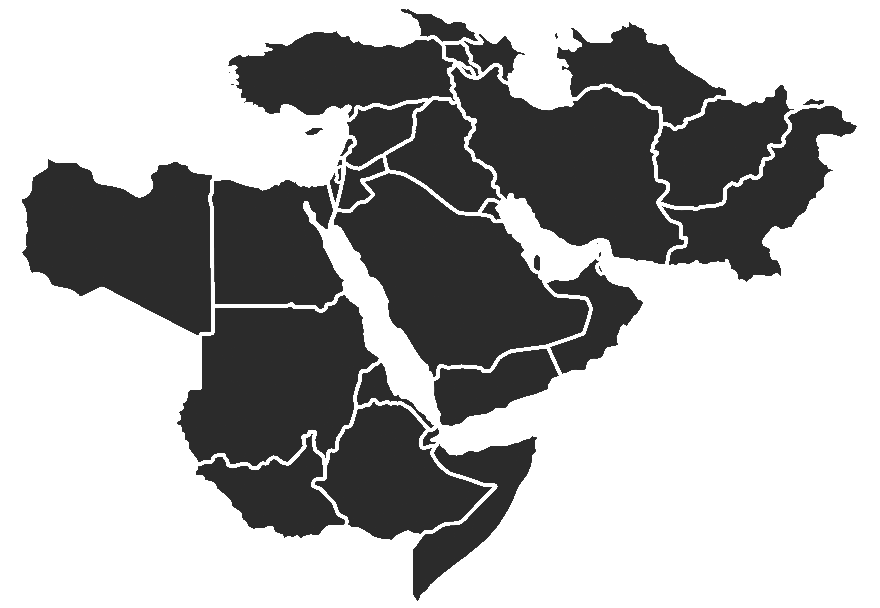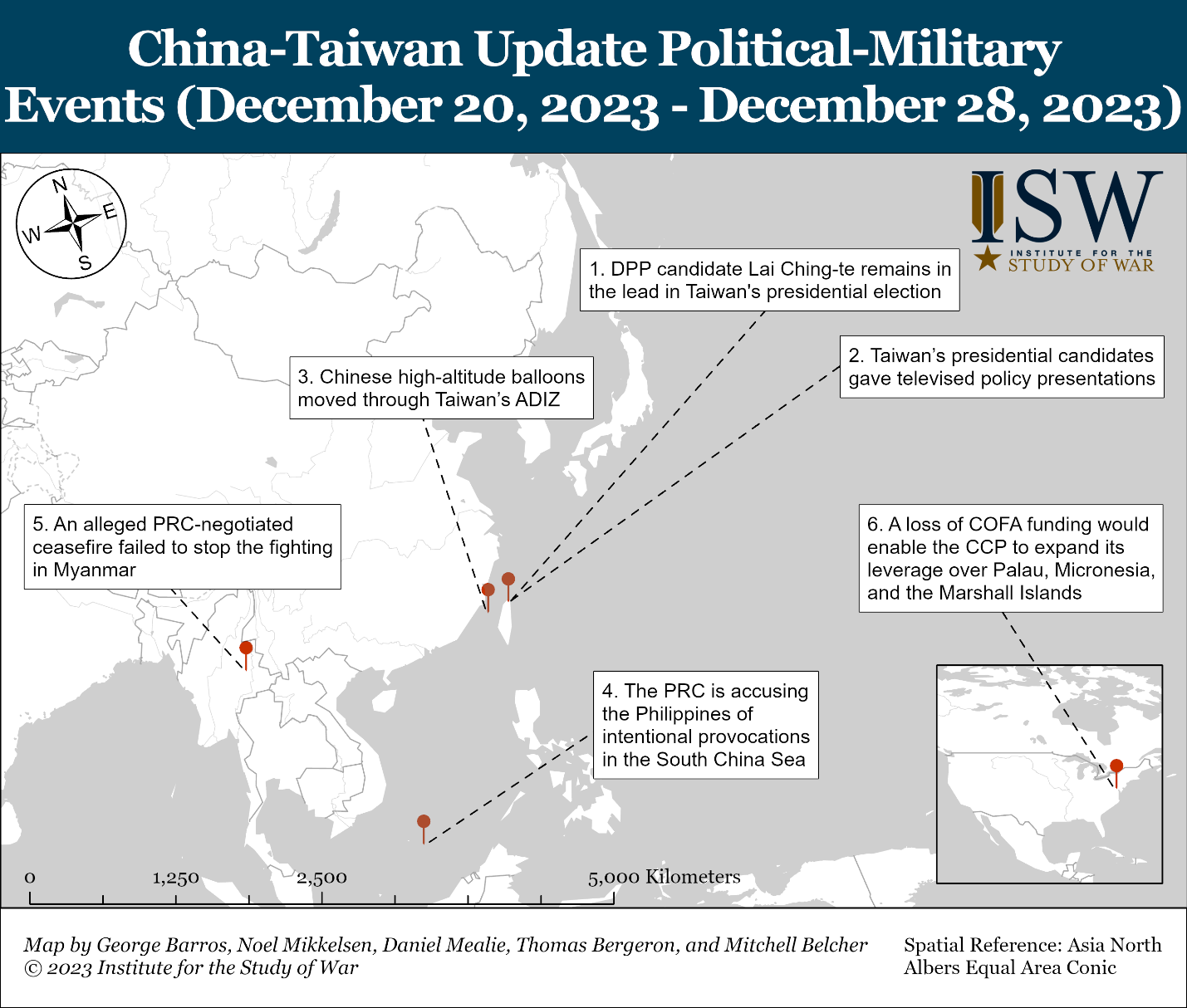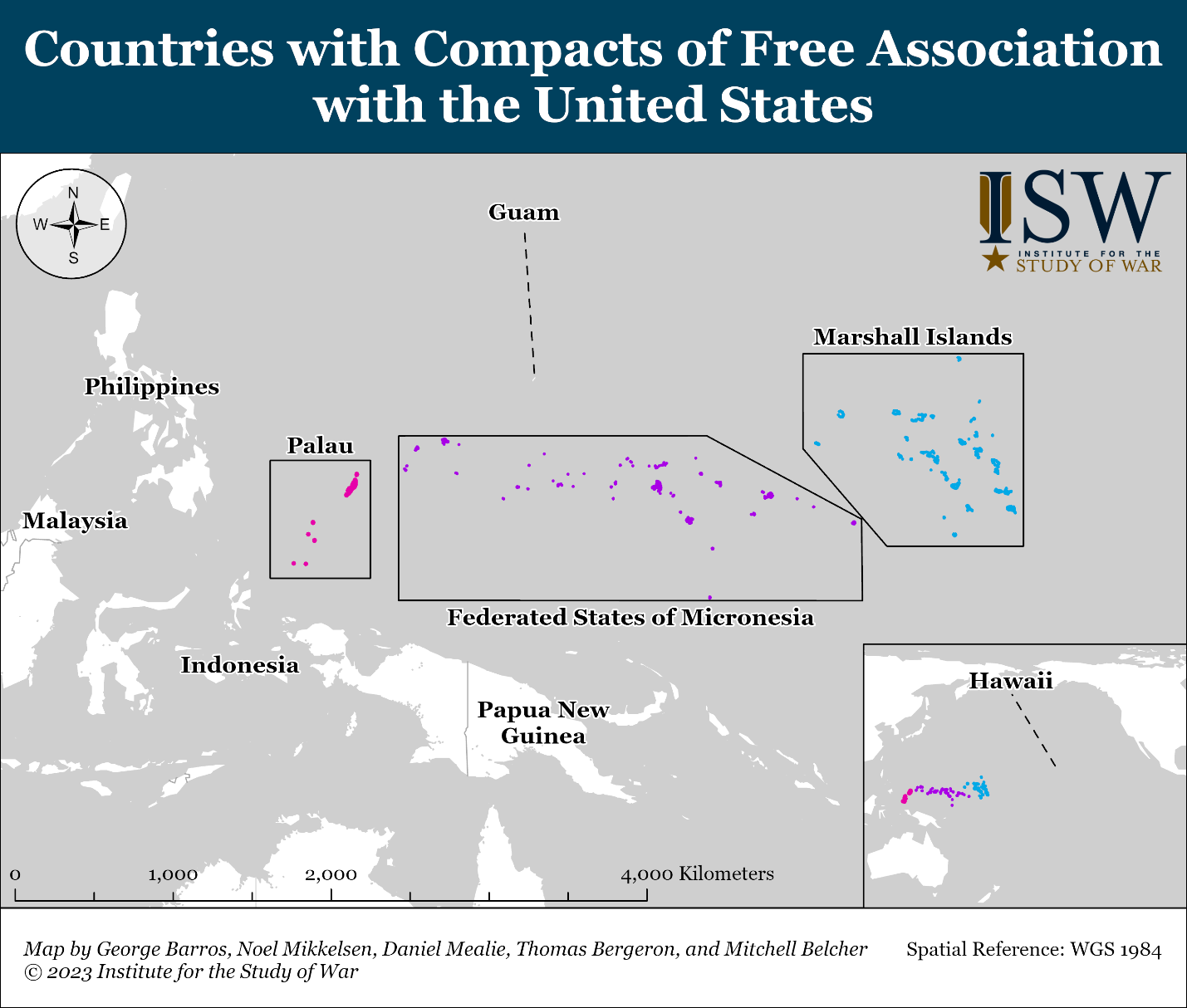{{currentView.title}}
December 28, 2023
China-Taiwan Weekly Update, December 28, 2023
Editors: Dan Blumenthal and Frederick W. Kagan of the American Enterprise Institute
Data Cutoff: December 28, 2023 at 5pm EST
The China–Taiwan Weekly Update focuses on the Chinese Communist Party’s paths to controlling Taiwan and relevant cross–Taiwan Strait developments.
Key Takeaways
- Democratic Progressive Party (DPP) presidential candidate Lai Ching-te remains first in the polls.
- Two Chinese high-altitude balloons have moved through Taiwan’s Air Defense Identification Zone (ADIZ) since December 20.
- The People's Republic of China (PRC) continued to accuse the Philippines of “colluding with external forces” and deliberately provoking confrontations after a series of maritime confrontations in the South China Sea in December.
- A PRC-brokered ceasefire agreement has failed to stop the fighting between the government of Myanmar and three rebel groups in Myanmar.
- A loss of Compacts of Free Association funding for Palau, Micronesia, and the Marshall Islands would enable the Chinese Communist Party (CCP) to expand its leverage points over these countries.
Taiwan
Democratic Progressive Party (DPP) presidential candidate Lai Ching-te continues to lead in the polls. The polls that Formosa and ETtoday released between December 20 through December 24 showed that Lai has a roughly 5% lead over Kuomintang (KMT) presidential candidate Hou Yu-ih.[i] The Poll of Polls, which is a weighted average of public election polls over the past 15 days that Taiwan News publishes, showed a similar lead for Lai as of December 25. Lai received 34.91% support, Hou received 30.49% support, and Taiwan People’s Party (TPP) candidate Ko Wen-je received 20.90% support, according to the aggregated polling numbers.[ii] The support levels do not reflect significant change since last week.
Two Formosa polls from December 25 and 26 indicate that Lai’s lead over Hou is steadily increasing. The December 25 poll showed Lai at 37.5% support compared to Hou’s 30.49%.[iii] The December 26 poll showed Lai at 38.9% support compared to Hou’s 29.4%.[iv] This is the largest gap between the candidates since the November 15 Formosa polling. It is also the first time that Hou has fallen below 30% support since then.[v]
The increase in support for Lai may be due to a shift in young voters from Ko. Support for Lai among the 20-29 and 30-39 age groups in the December 26 Formosa poll was 34.8% and 31.0%, respectively.[vi] Lai’s polling among the 20-29 age group increased from 20.8% in Formosa’s December 21 poll and has held steady between 34-35% through Formosa’s December 22-26 polling. Lai’s polling among the 30-39 age group decreased slightly between December 22 and 25 from 34.7% to 27.6% before increasing back to 31% on December 26.[vii] Support for Ko among the same demographics was 29.9% and 30.4% on December 26.[viii] Ko’s support among the 20-29 age group fell from a high of 38.2% on December 22 and support within the 30-39 age group has remained steady at 30-31%.[ix]
Hou’s decline in polling could be partly attributed to a decrease in support among the KMT voter base. Support for Hou within the KMT base fell from 91.9% on December 20 to 87.5% on December 26, according to the latest Formosa poll. Support among his base had been above 90% since candidate registration on November 24.[x]
Taiwan’s three presidential candidates gave televised policy presentations on December 20, 26, and 28. Cross-strait issues featured heavily in all three presentations. Taiwan’s political status, sovereignty, and trade with the People’s Republic of China (PRC) were some of the most in-focus topics. Candidates also discussed a wide range of domestic political issues, such as public security, housing, and energy policy.
DPP candidate Lai Ching-te used his time to highlight the looming threat from the People’s Republic of China (PRC) and emphasize the importance of upholding Taiwan’s sovereignty. Lai related domestic governance to cross-strait issues, asserting that equitable development and economic prosperity hinged on preserving Taiwan’s democracy in the face of authoritarian expansion.[xi] Lai likened economic treaties between Taiwan and the PRC as conforming to the One-China principle and urged for separate economic development initiatives to counteract the PRC’s weaponization of trade for political leverage.[xii] The One-China principle describes the PRC's position that the PRC is the sole legal representative of China and that Taiwan is a part of China. Neither Taiwan nor the United States recognize the One-China principle.
KMT presidential candidate Hou Yu-ih mostly focused on promoting domestic governance proposals while criticizing Lai and the DPP administration for encouraging formal Taiwanese independence.[xiii] Hou defended the KMT’s cross-strait policy against claims of alignment with unification, stressing his fundamental support for Taiwan’s democracy and freedom.[xiv] Hou disparaged the DPP for what the KMT perceives as independence-minded policies that are directly harmful to the livelihoods of Taiwan’s citizens. Hou pointed to the PRC’s December 21 suspension of tariff reductions under the Cross-Strait Economic Cooperation Framework Agreement (ECFA) as a consequence of the DPP’s inflammatory approach to cross-strait relations.[xv] The PRC Taiwan Affairs Office (TAO) spokesperson Chen Binhua blamed the DPP’s “separatist stance” for the tariff reduction suspension on December 27.[xvi] The Chinese Communist Party (CCP) consistently points to the DPP’s alleged secessionism as the source of tension in cross-strait relations.[xvii]
TPP candidate Ko Wen-je emphasized domestic governance issues, keeping with his appeal to voters who are weary of cross-strait issues dominating the political discourse. Ko addressed issues such as Taiwan’s aging population, housing policy, and government reforms.[xviii] Ko presented his cross-strait policy as an alternative to the polarizing extremes of an independence-focused DPP and unification-focused KMT. Ko accused his opponents of promoting cross-strait policies that disrupt the status quo and are unacceptable to both the Taiwanese public and the international community.[xix] Ko asserted Taiwan’s status as a sovereign and independent nation while advocating for pragmatic diplomacy that balances cross-strait engagement with strong international partnerships and national defense capabilities. [xx]
The three vice-presidential candidates also gave a televised policy presentation on December 22. The candidates’ messaging reflected that of their running mates. DPP vice-presidential candidate Hsiao Bi-khim criticized the KMT for proposing a trade policy that would increase Taiwan’s economic reliance on the PRC at a time when other countries were reducing their economic exposure to the PRC.[xxi] KMT vice-presidential candidate Jaw Shaw-kong used strong language to criticize the DPP and Lai’s independence stance, referring to the latter as a “terrorist” endangering cross-strait relations.[xxii] TPP vice-presidential candidate Cynthia Wu did not discuss cross-strait issues and instead emphasized economic issues.[xxiii] The vice-presidential candidates maintain a relatively strong presence in the public eye thanks to their high-profile positions in government and media, making their policy presentation potentially more consequential to the race.
The format of the presidential and vice-presidential presentations was similar to that of a debate. The candidates shared the stage to articulate policy stances and often used their allotted time to criticize each other. The presidential candidates will participate in a formal televised debate on December 30. The vice-presidential candidates will participate in a debate on January 1.
Two Chinese high-altitude balloons have moved through Taiwan’s Air Defense Identification Zone (ADIZ) since December 20. One balloon crossed the median line of the Taiwan Strait on December 22 and the other crossed the median line on December 24.[xxiv] Five other balloons previously crossed the median line between December 7 and 19.[xxv] The balloons floated at altitudes between 12,000 and 26,000 feet. [xxvi] Taiwan’s Ministry of National Defense (MND) reported a similar balloon above Taipei on February 10.[xxvii] The MND and the director-general of Taiwan’s Central Weather Service have also reported at least seven balloon sightings over Taiwan between 2021 and 2022. The Financial Times quoted unnamed Taiwanese officials as stating Chinese balloons “come very frequently” and “on average once a month” in a February 12 report.[xxviii] The unnamed officials stated that the February balloons’ dimensions and payload “put them outside the scope of ordinary weather balloons.”[xxix]
The PRC sending the balloons across the median line of the Taiwan Strait is likely part of a broader effort to wear down Taiwan’s resources and response capabilities. The PRC has normalized daily air and naval activities around Taiwan, including near-daily aerial crossings of the median line in the Taiwan Strait, since 2020. The MND publicly stated that the balloons were weather balloons but has started including them among its daily reports of PRC ADIZ incursions since December 8.[xxx] MND’s unprecedented inclusion of balloon flights in its daily updates and maps of ADIZ violations in December shows that Taiwan is increasingly concerned about these balloons and may consider them part of the PRC’s broader coercion campaign.
South China Sea
The PRC continued to accuse the Philippines of “colluding with external forces” and deliberately provoking confrontations after a series of maritime confrontations in the South China Sea in December. On December 9 and 10, Chinese Coast Guard (CCG) vessels attempted to thwart Philippine supply missions near Scarborough and Second Thomas Shoals by firing water cannons and acoustic weapons at Philippine government ships delivering supplies. A CCG vessel rammed a Philippine ship near Second Thomas Shoal.[xxxi] Both countries claim both maritime features. The PRC administers Scarborough Shoal since seizing control of it in 2012, while the Philippines administers Second Thomas Shoal.
Chinese Foreign Minister Wang Yi attributed the recent “difficulties” to the Philippines' “altered policy stance, failure to uphold commitments, and provocative actions in disputed waters” during a December 20 phone call with Philippine Foreign Minister Enrique Manalo. Wang said that Beijing wished to resolve the disputes through consultation but warned of “resolute responses” if the Philippines continued its “disruptive actions.”[xxxii] The MFA spokesperson said on December 25 that the Philippines had “repeatedly violated and provocatively violated relevant waters in the South China Sea, spread false information, and colluded with external forces to undermine peace and stability in the South China Sea.”[xxxiii] PRC state media, such as People’s Daily, also wrote that the Philippines relied on US support to “provoke” the PRC.[xxxiv] The PRC Ministry of Foreign Affairs (MFA) also harshly criticized and warned the Philippines through December 26. The Philippines denied on December 26 that it had acted provocatively and instead blamed the PRC for escalating its tactics.[xxxv]
The United States and Japan have shown support for the Philippines during the recent disputes with the PRC. The US, Japanese, and Filipino national security advisors participated in a trilateral call on December 13 in which they denounced the PRC’s aggression against the Philippines and expressed their commitment to closer security cooperation.[xxxvi] Japan also provided the Philippine Air Force with an advanced air surveillance radar system on December 20. The provision was part of a $110 million deal for four units that Japan and the Philippines signed in 2020. The radar system will help the Philippines detect intrusions around any part of the country and its claimed territories. This transfer marks Japan’s first export of a complete defense product since it eased its arms trade ban in 2014.[xxxvii]
Myanmar
A PRC-brokered ceasefire agreement has failed to stop the fighting between the government of Myanmar and three rebel groups in Myanmar. Three ethnic rebel groups formed a “brotherhood alliance” and began an offensive in northern Myanmar against the ruling junta on October 27. The Chinese Ministry of Foreign Affairs claimed on December 14 that it had brokered a temporary ceasefire between the Myanmar military government and the three allied rebel groups.[xxxviii] The PRC MFA spokesperson confirmed on December 19 and 20 that the PRC had hosted ceasefire negotiations in Kunming that resulted in an agreement on December 14. He said the PRC was working to get the warring parties to implement the terms of the agreement, exercise “maximum restraint,” and “properly manage occasional frictions during the ceasefire process.”[xxxix] Fighting between the rebel factions and the government has continued throughout Myanmar, however. A rebel group captured the border town of Namhsan one day after the alleged ceasefire on December 15.[xl] Rebels also carried out attacks on military bases and bombings in the major cities of Yangon and Mandalay.[xli] The PRC MFA spokesperson confirmed on December 19 and 20 that the PRC had hosted ceasefire negotiations in Kunming that resulted in an agreement on December 14. He said the PRC was working to get the warring parties to implement the terms of the agreement, exercise “maximum restraint,” and “properly manage occasional frictions during the ceasefire process.”[xlii]
The MFA has repeatedly urged the belligerent parties to maintain the security and stability of the PRC-Myanmar border and safeguard the safety of Chinese projects and personnel in Myanmar.[xliii] The fighting has resulted in the deaths of an unspecified number of PRC nationals. One such incident was possibly due to an artillery shell that the junta forces fired which landed in the PRC. [xliv] The fighting has also blocked PRC–Myanmar cross-border trade and sent thousands of Myanmar nationals to briefly seek safety in the PRC.[xlv] [xlvi] The CCP may also seek to negotiate a ceasefire to bolster its diplomatic reputation. The PRC has often portrayed itself as a promoter of global peace, security, and stability, for example through its Global Security Initiative.[xlvii]
The PRC has also been using the fighting to crack down on cyber scam centers based in northern Myanmar, which defraud Chinese nationals and have kidnapped thousands of Chinese to work for them.[xlviii] The PRC has offered rewards for the capture of criminal leaders and carried out joint policing with Myanmar authorities, which culminated in Myanmar authorities handing over 31,000 cybercrime suspects to the PRC as of November 21.[xlix] The junta has since said it is limited in its ability to do more because the scam centers are in areas held by rebel groups.[l] The allied rebel groups have also targeted cyber scam centers and announced eradicating such centers as a major goal of their offensive.[li]
Israel-Hamas War
Chinese state media portrayed the U.S.-proposed “Guardian Shield” multinational Red Sea naval task force as a self-serving and ineffective move that will worsen the situation in the Red Sea and the Middle East. Chinese state media questioned the effectiveness of the initiative and accused the U.S. of being biased and hegemonic in its approach.[lii] Chinese media analysis of the situation acknowledged the global implications of the Red Sea crisis, such as the disruption of shipping routes, the increase in costs and prices, and the pressure on the supply chain, but dismissed Guardian Shield as a "band-aid.”[liii] State-controlled media outlets emphasized that the “root cause of a series of problems in the Middle East … lies in the Palestinian-Israeli conflict” and stressed the need for a ceasefire.[liv] The PRC has not signaled any willingness or interest to support the U.S.-led regional security initiatives to protect maritime shipping through the Bab al Mandeb and Red Sea.[lv]
The reaction from Chinese state media aligns with the PRC’s diplomatic and information lines of effort that aim to supplant U.S. influence with Arab states by proposing what it claims to be a more inclusive and cooperative regional security framework.[lvi] This involves portraying Washington as a self-interested and destabilizing influence in the region while simultaneously positioning Beijing as an altruistic and unbiased actor.[lvii]
Compacts of Free Association
A loss of Compacts of Free Association (COFA) funding for Palau, Micronesia, and the Marshall Islands would enable the CCP to expand its leverage points over these countries. These COFAs govern the United States’ relationship with Palau, Micronesia, and the Marshall Islands while also granting the United States extensive military access throughout their territories. The United States renewed COFAs with Palau and Micronesia in May.[lviii] It then did so with the Marshall Islands in October.[lix] The signed agreements are now before Congress for funding consideration. Congress previously funded the COFAs for a twenty-year period in 2003.[lx] The total cost for all three of the twenty-year agreements would be roughly $7 billion spread over the period 2024 to 2043, according to the Congressional Research Service.[lxi] Deputy Secretary of State nominee Kurt Campbell stated during his Senate confirmation hearing on December 7 that “if we don’t get it [COFA funding] you can expect that literally the next day Chinese diplomats — military and other folks — will be on the plane…trying to secure a better deal for China.”[lxii] The US House of Representatives Select Committee on the Strategic Competition between the United States and the Chinese Communist Party also called for renewing the COFAs in a mid-December report.[lxiii] President Biden signed the 2024 National Defense Authorization Act into law on December 22, but it did not include COFA funding.[lxiv]
These three island countries control key sea lanes that provide a secure route connecting American allies and partners, such as the Philippines and Taiwan, to the US territory of Guam and the state of Hawaii. Palau and the Marshall Islands are 2 of the 13 countries that maintain official diplomatic relations with Taiwan.[lxv]
The loss of COFA funding would present an opportunity for the CCP to expand its economic influence with these vital Pacific Island countries. For example, this funding loss would exacerbate Palau’s existing deficit, which amounts to $37 million as of its 2021 budget of $150 million.[lxvi] This is an economic vulnerability that the CCP could partially fill by encouraging PRC nationals to vacation in Palau. The CCP cut tourism to Palau over the last decade to nearly zero as punishment for maintaining full diplomatic relations with Taiwan.[lxvii] The reversal of this CCP policy would provide the party with economic leverage to wield over Palau in the event of future policy disagreements. The expansion of the CCP’s economic influence in Palau would also provide the party a leverage point to coerce the countries into switching diplomatic recognition from Taiwan to the People's Republic of China (PRC). The PRC aims to coerce countries into switching diplomatic recognition to falsely argue that Taiwan is a province of the People’s Republic of China rather than a legitimate country named the Republic of China.
The loss of COFA funding would also exacerbate the CCP narrative put forth by the propaganda outlet Global Times that the United States only cares about Palau for security reasons rather than mutually beneficial cooperation. [lxviii] The Palau Senate passed a resolution in November rejecting the permanent deployment of a US Patriot missile defense battery.[lxix] This was the first instance of lawmakers challenging President Surangel Whipps Jr’s request for the United States to construct an over-the-horizon radar system in Palau.[lxx] The associated fiscal cliff that Palau faces without COFA funding buttresses the CCP’s narrative, which in turn creates hurdles for deploying mutually beneficial United States defense resources to the country.
The loss of COFA funding would also provide the CCP an opportunity to expand influence efforts targeting Micronesian political elites. The CCP has completed infrastructure projects throughout the country, such as houses for the country’s president, vice president, speakers of congress, and chief justice.[lxxi] Axios reported that former Micronesian officials confirmed receiving gifts from the PRC, such as money, while on official state visits to the country.[lxxii] The lack of COFA funding would exacerbate the appeal of CCP monetary gifts or infrastructure projects that target the Micronesian political elite. Micronesian President Wesley Simina also stated in late November that his country would be at a “fiscal cliff” without US Congressional approval of COFA funding. This would mean that “we [Micronesia] will have to find different sources of funding… and that’s not out there available immediately.”[lxxiii] The loss of COFA funding would also provide opportunities for external powers such as the CCP to enhance their economic influence in the country by filling these funding gaps.
[i] http://my-formosa dot com/DOC_202042.htm
http://my-formosa dot com/DOC_202091.htm
http://my-formosa dot com/DOC_202138.htm
https://udn dot com/news/story/123307/7658274?from=udn-catelistnews_ch2
[ii] https://www.taiwannews dot com.tw/en/news/5065802
[iii] http://my-formosa dot com/DOC_202182.htm
[iv] http://www.my-formosa dot com/DOC_202223.htm
[v] https://www.taiwannews dot com.tw/en/news/5066367
http://www.my-formosa dot com/DOC_200343.htm
[vi] http://www.my-formosa dot com/DOC_202223.htm
[vii] http://my-formosa dot com/DOC_202042.htm
http://my-formosa dot com/DOC_202091.htm
http://my-formosa dot com/DOC_202138.htm
http://my-formosa dot com/DOC_202182.htm
http://www.my-formosa dot com/DOC_202223.htm
[viii] http://www.my-formosa dot com/DOC_202223.htm
[ix] http://my-formosa dot com/DOC_202042.htm
http://www.my-formosa dot com/DOC_202223.htm
[x] http://www.my-formosa dot com/DOC_202223.htm
[xi] https://www.chinatimes dot com/realtimenews/20231226003237-260407
[xii] https://www.chinatimes dot com/realtimenews/20231228005428-260407
https://www.chinatimes dot com/realtimenews/20231228005354-260407
[xiii] https://news.ltn dot com.tw/news/politics/breakingnews/4527113
[xiv] https://www.chinatimes dot com/realtimenews/20231228005137-260407
[xv] https://www.chinatimes dot com/realtimenews/20231226003337-260407?ctrack=pc_main_rtime_p01
[xvi] http://www.gwytb dot gov.cn/m/speech/202312/t20231227_12590231.htm
[xvii] http://paper.people dot com.cn/rmrbhwb/html/2021-06/10/content_3053019.htm
[xviii] https://www.cna dot com.tw/news/aipl/202312200383.aspx
https://news.ltn dot com.tw/news/politics/breakingnews/4527209
https://www.chinatimes dot com/realtimenews/20231226004083-260407
https://www.chinatimes dot com/realtimenews/20231226003345-260407
https://udn dot com/news/story/123307/7666453#:~:text=%E4%BB%96%E6%8F%90%E5%87%BA%E3%80%8C%E6%B2%BB%E5%AE%89%E4%B8%89%E7%AE%AD,%E6%8E%83%E9%BB%91%E6%A7%8D%E3%80%81%E9%99%A4%E6%9A%B4%E3%80%82%E3%80%8C
[xix] https://www.chinatimes dot com/realtimenews/20231228005216-260407
[xx] https://www.cna dot com.tw/news/aipl/202312200337.aspx
https://www.chinatimes dot com/realtimenews/20231228005258-260407a
https://www.chinatimes dot com/realtimenews/20231228005294-260407
[xxi] https://www.taiwannews dot com.tw/en/news/5064671
[xxii] https://focustaiwan dot tw/cross-strait/202312220024
[xxiii] https://www.taiwannews dot com.tw/en/news/5064671
[xxiv] https://twitter.com/MoNDefense/status/1737296630167277721
https://twitter.com/MoNDefense/status/1738750781720023211
https://twitter.com/MoNDefense/status/1739455835619946849
[xxv] https://twitter.com/MoNDefense/status/1732986368685703539
https://twitter.com/MoNDefense/status/1736571074366837215
https://twitter.com/MoNDefense/status/1736921542939078885
https://twitter.com/MoNDefense/status/1737296630167277721
[xxvi] https://twitter.com/MoNDefense/status/1737296630167277721
https://twitter.com/MoNDefense/status/1738750781720023211
https://twitter.com/MoNDefense/status/1739455835619946849
[xxvii] https://twitter.com/MoNDefense/status/1624020370360778752?lang=bn
[xxviii] https://www.ft.com/content/023764a2-6af2-4fbb-b75d-dd607c907f6e
[xxix] https://www.ft.com/content/023764a2-6af2-4fbb-b75d-dd607c907f6e
[xxx] https://www.taiwannews dot com.tw/en/news/5061598
[xxxi] https://apnews.com/article/south-china-sea-philippines-second-thomas-shoal-scarborough-shoal-632cbc349007048cc2ad56502ef4fc67
[xxxii] https://www.fmprc dot gov.cn/wjbzhd/202312/t20231220_11208285.shtml
[xxxiii] https://www.fmprc dot gov.cn/fyrbt_673021/202312/t20231221_11209251.shtml
https://www.fmprc dot gov.cn/fyrbt_673021/202312/t20231226_11213135.shtml
https://www.fmprc dot gov.cn/wjbzhd/202312/t20231220_11208285.shtml
[xxxiv] http://paper.people dot com.cn/rmrb/html/2023-12/25/nw.D110000renmrb_20231225_2-18.htm
https://www.globaltimes dot cn/page/202312/1304373.shtml
[xxxv] https://www.voanews.com/a/philippines-not-provoking-conflict-in-south-china-sea-its-military-says/7412754.html
[xxxvi] https://www.whitehouse.gov/briefing-room/statements-releases/2023/12/13/readout-of-national-security-advisor-jake-sullivans-call-with-the-national-security-advisors-of-japan-and-the-philippines/
[xxxvii] https://www.japantimes.co.jp/news/2023/12/20/japan/philippines-radar-system/
[xxxviii] https://www.fmprc dot gov.cn/fyrbt_673021/jzhsl_673025/202312/t20231214_11202528.shtml
[xxxix] https://www.fmprc dot gov.cn/fyrbt_673021/jzhsl_673025/202312/t20231220_11208066.shtml
https://www.fmprc dot gov.cn/fyrbt_673021/jzhsl_673025/202312/t20231219_11207018.shtml
[xl] https://www.france24.com/en/asia-pacific/20231216-myanmar-s-three-brotherhood-alliance-seizes-town-from-military-despite-china-backed-ceasefire
[xli] https://asia.nikkei.com/Spotlight/Myanmar-Crisis/Myanmar-fighting-continues-despite-Beijing-mediated-cease-fire
[xliii] https://www.fmprc dot gov.cn/fyrbt_673021/202312/t20231221_11209251.shtml
[xliv] https://www.irrawaddy dot com/news/burma/beijing-confirms-chinese-casualties-in-myanmar-border-battle.html
[xlv] https://www.rfa.org/english/news/myanmar/refugees-return-11072023063502.html
[xlvi] https://apnews.com/article/myanmar-yan-lon-kyaing-border-gate-mndaa-6f1da5e94516e52eeb98bfca74c6f8bc
[xlvii] https://www.gov dot cn/xinwen/2023-02/21/content_5742481.htm
[xlviii] https://www.bloomberg.com/news/articles/2023-12-20/china-is-using-myanmar-civil-war-to-destroy-cyber-scam-networks
[xlix] https://www.globaltimes dot cn/page/202311/1302223.shtml
https://www.scmp dot com/news/china/diplomacy/article/3246235/china-pushes-more-security-operations-along-mekong-summit-southeast-asian-neighbours
[l] https://www.bloomberg.com/news/articles/2023-12-20/china-is-using-myanmar-civil-war-to-destroy-cyber-scam-networks
[li] https://twitter.com/kokang0123/status/1717859771184034207
[lii] http://www.news[dot]cn/mil/2023-12/20/c_1212317795.htm
[liii] http://www.news[dot]cn/mil/2023-12/20/c_1212317888.htm
https://www.globaltimes[dot]cn/page/202312/1303992.shtml
[liv] http://www.news[dot]cn/mil/2023-12/20/c_1212317741.htm
https://www.globaltimes[dot]cn/page/202312/1303992.shtml
[lv]https://www.state.gov/secretary-blinkens-call-with-peoples-republic-of-china-prc-director-of-the-office-of-the-foreign-affairs-commission-and-foreign-minister-wang-yi-2/
https://www.state.gov/briefings/department-press-briefing-december-19-2023/
https://www.fmprc.gov[dot]cn/fyrbt_673021/202312/t20231221_11209251.shtml
[lvi] https://www.fmprc.gov[dot]cn/zwbd_673032/wjzs/202312/t20231226_11212966.shtml
https://www.fmprc.gov[dot]cn/zwbd_673032/wjzs/202312/t20231226_11212967.shtml
https://www.fmprc.gov[dot]cn/zwbd_673032/wjzs/202312/t20231227_11213522.shtml
[lvii] https://www.fmprc.gov[dot]cn/fyrbt_673021/202312/t20231211_11199542.shtml
http://un.china-mission.gov[dot]cn/chn/hyyfy/202312/t20231220_11207420.htm
scmp[dot]com/news/china/diplomacy/article/3246266/why-hasnt-china-joined-us-led-naval-force-against-houthi-rebel-attacks-red-sea?module=top_story&pgtype=homepage
[lviii] https://www.state.gov/secretary-blinken-witnesses-the-signing-of-the-u-s-palau-2023-agreement-following-the-compact-of-free-association-section-432-review/
https://www.reuters.com/world/asia-pacific/us-signs-agreement-continue-micronesia-assistance-under-strategic-pact-2023-05-23/
[lix] https://www.reuters.com/world/us-negotiator-expects-sign-new-deal-with-strategic-marshall-islands-monday-2023-10-16/
[lx] https://crsreports.congress.gov/product/pdf/IF/IF12194#:~:text=In%202003%2C%20the%20United%20States,years%20(FY2004%2DFY2023).
[lxi] https://crsreports.congress.gov/product/pdf/IF/IF12194#:~:text=In%202003%2C%20the%20United%20States,years%20(FY2004%2DFY2023).
[lxii] https://www.reuters.com/world/us/campbell-stresses-need-us-approve-deals-with-pacific-islands-2023-12-07/
[lxiii] https://selectcommitteeontheccp.house.gov/sites/evo-subsites/selectcommitteeontheccp.house.gov/files/evo-media-document/reset-prevent-build-scc-report.pdf
[lxiv] https://www.congress.gov/bill/118th-congress/house-bill/2670/text
https://www.defense.gov/News/News-Stories/Article/Article/3252968/biden-signs-national-defense-authorization-act-into-law/
[lxv] https://www.reuters.com/world/asia-pacific/palau-says-committed-supporting-taiwan-despite-mounting-aggressions-2022-10-06/
https://www.reuters.com/world/china/marshall-islands-says-strongly-committed-taiwan-ties-2022-03-22/
[lxvi] https://www.voanews.com/a/analysts-congressional-budget-battle-gives-beijing-opening-in-the-pacific/7300301.html
[lxvii] https://apnews.com/article/japan-palau-us-china-taiwan-pacific-islands-add711bf4a7989faca33e883359f2458
[lxviii] https://www.globaltimes dot cn/page/202312/1304091.shtml
[lxix] https://www.reuters.com/world/us-missile-defense-proposal-stirs-debate-palau-2023-12-20/#:~:text=However%2C%20in%20late%20November%2C%20the,yet%20to%20consider%20the%20issue.
[lxx] https://www.pacificislandtimes.com/post/amid-heightened-tensions-palau-s-senate-rejects-missile-deployment
[lxxi] https://www.fsmgov.org/press/pr092206.htm
https://www.axios.com/american-military-chinese-competition-micronesia
[lxxii] https://www.axios.com/american-military-chinese-competition-micronesia
[lxxiii] https://www.rnz.co.nz/international/pacific-news/503173/fsm-faced-with-a-fiscal-cliff-president-simina-says



